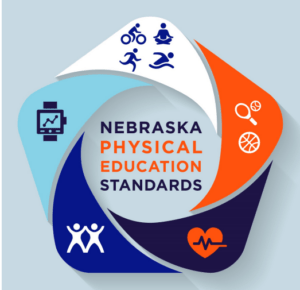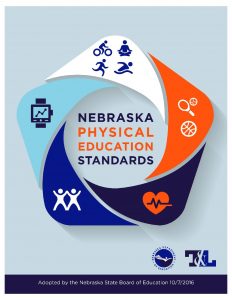Physical Education is an integral part of total education of a child. It is the cornerstone in developing an active lifestyle, providing opportunities to guide young people in the process of becoming physically active for a lifetime. Quality physical education programs increase the physical competence, health-related fitness, self-responsibility, and enjoyment of physical activity for young people and includes the following: skill development, regular healthful physical activity, improved physical fitness, support for other subject areas, self-discipline, improved judgment, stress reduction, strengthened peer relations, improved self-confidence and self-esteem, and goal setting. The Nebraska Physical Education Standards serves as guidance to help schools achieve this goal.
Mission of Physical Education
Physical activity is critical to the development and maintenance of good health. The goal of physical education is to develop physically educated individuals who have the knowledge, skills, and confidence to enjoy a lifetime of healthful physical activity.
A physically educated person:
- Demonstrates competency in motor skills and movement patterns needed to perform a variety of physical activities.
- Demonstrates understanding of movement concepts, principles, strategies, and tactics as they apply to the learning and performance of physical activities.
- Participates regularly in physical activity.
- Achieves and maintains a health-enhancing level of physical fitness.
- Exhibits responsible personal and social behavior that respects self and others in physical activity settings.
- Values physical activity for health enjoyment challenge, self-expression and/or social interaction.
An appropriate physical education program ensures that individuals with disabilities have access to a program that enables them to achieve the same goals in physical education as their peers without disabilities. Students identified by an individualized education program (IEP) team who do not meet age appropriate curricular benchmarks should be provided the necessary supplementary aids and support services in the least restrictive environment. Instruction, equipment, activity rules, and the environmental set-up should be modified as necessary to provide an appropriate, safe, and comfortable educational setting.
News & Notes
Walk to Unlock Nebraska
A Virtual Learning & Physical Activity Challenge
Walk to Unlock Nebraska invites students and teachers to combine exercise and learning through a fun, competitive virtual platform that rewards physical activity with fascinating historical, geographical, and agriculture information about our state.
- This learning experience is targeted for students in kindergarten through eighth grade
- Multiple lesson topics include science, social studies, math, language arts, nutrition and more
- Integrated curricular ideas are included to be used as tools for learning both in the classroom and at home
- Virtual field trips are available to enhance the journey





 SAVE THE DATE
SAVE THE DATE
